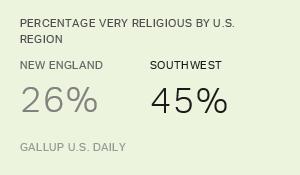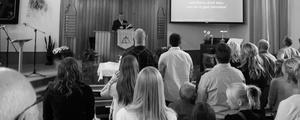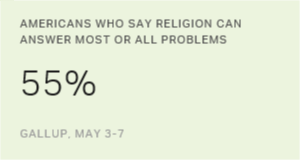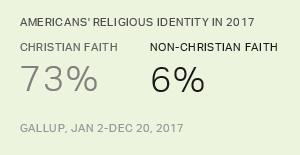Story Highlights
- 45% in Southwest are "very religious," the most religious U.S. region
- 26% are "very religious" in New England, the least religious region
WASHINGTON, D.C. -- The Southwest and Southeast regions of the United States lived up to their reputation as the home of the nation's Bible Belt in 2017, producing nine of the nation's 11 most religious states. In contrast, the Pacific and New England regions have 10 of the 11 least religious states for the year.
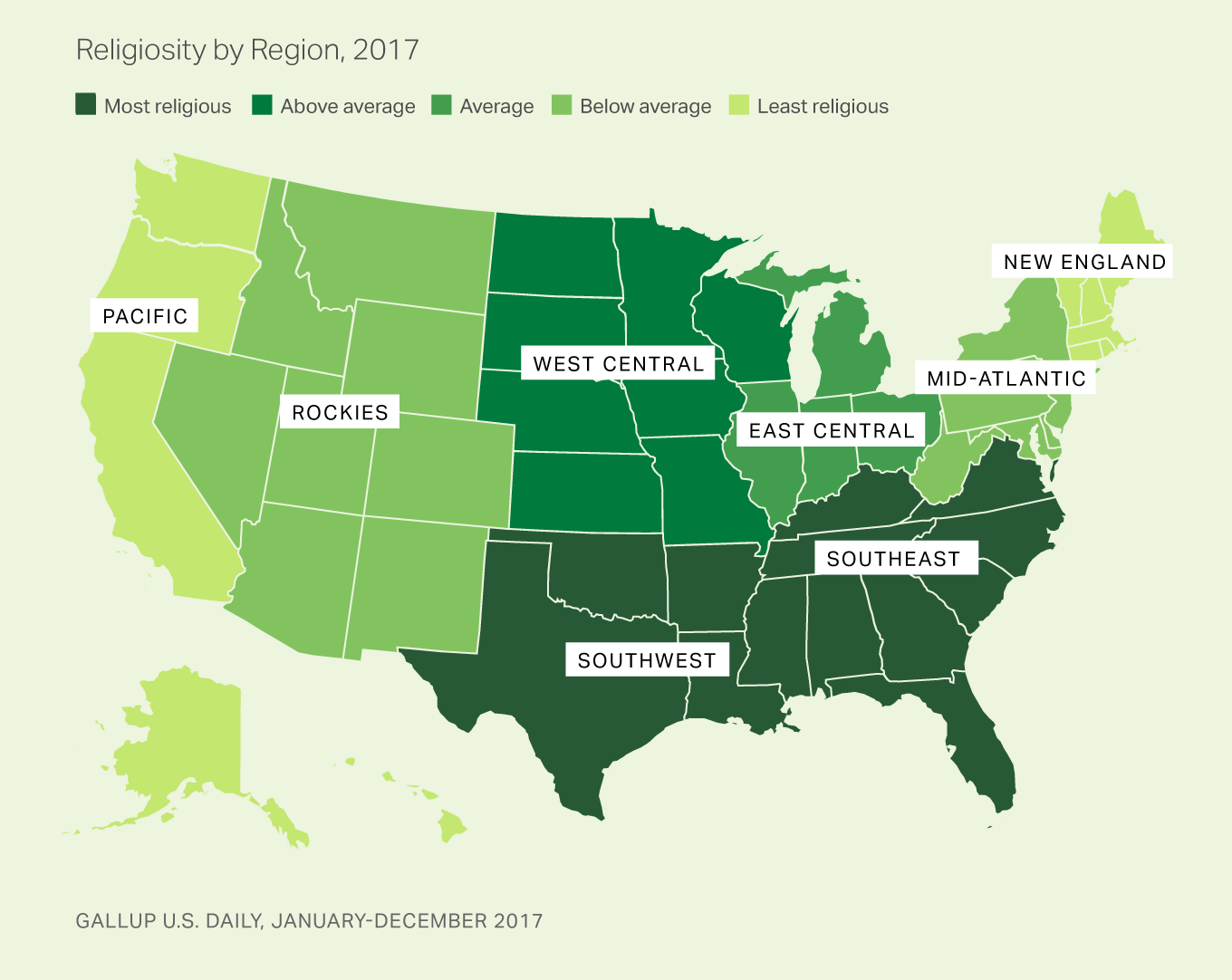
Forty-five percent of Americans living in the Southwest and 43% in the Southeast are "very religious" -- a classification based on how important people say religion is to them and how often they attend religious services. They are the only two of the nation's eight regions with at least 40% of their residents classified as very religious. The percentage is below 30% in the Pacific and New England regions, while religiosity is in the 30s across the center of the country from the Rockies to the Mid-Atlantic.
| Very religious | Moderately religious | Not religious | |||||||||||||||||||||||||||||||||||||||||||||||||||||||||||||||||||||||||||||||||||||||||||||||||
|---|---|---|---|---|---|---|---|---|---|---|---|---|---|---|---|---|---|---|---|---|---|---|---|---|---|---|---|---|---|---|---|---|---|---|---|---|---|---|---|---|---|---|---|---|---|---|---|---|---|---|---|---|---|---|---|---|---|---|---|---|---|---|---|---|---|---|---|---|---|---|---|---|---|---|---|---|---|---|---|---|---|---|---|---|---|---|---|---|---|---|---|---|---|---|---|---|---|---|---|
| % | % | % | |||||||||||||||||||||||||||||||||||||||||||||||||||||||||||||||||||||||||||||||||||||||||||||||||
| Southwest | 45 | 31 | 23 | ||||||||||||||||||||||||||||||||||||||||||||||||||||||||||||||||||||||||||||||||||||||||||||||||
| Southeast | 43 | 31 | 26 | ||||||||||||||||||||||||||||||||||||||||||||||||||||||||||||||||||||||||||||||||||||||||||||||||
| West Central | 39 | 29 | 32 | ||||||||||||||||||||||||||||||||||||||||||||||||||||||||||||||||||||||||||||||||||||||||||||||||
| East Central | 37 | 29 | 34 | ||||||||||||||||||||||||||||||||||||||||||||||||||||||||||||||||||||||||||||||||||||||||||||||||
| Rockies | 35 | 27 | 38 | ||||||||||||||||||||||||||||||||||||||||||||||||||||||||||||||||||||||||||||||||||||||||||||||||
| Mid-Atlantic | 33 | 30 | 36 | ||||||||||||||||||||||||||||||||||||||||||||||||||||||||||||||||||||||||||||||||||||||||||||||||
| Pacific | 29 | 28 | 43 | ||||||||||||||||||||||||||||||||||||||||||||||||||||||||||||||||||||||||||||||||||||||||||||||||
| New England | 26 | 26 | 48 | ||||||||||||||||||||||||||||||||||||||||||||||||||||||||||||||||||||||||||||||||||||||||||||||||
| GALLUP U.S. DAILY, JANUARY-DECEMBER 2017 | |||||||||||||||||||||||||||||||||||||||||||||||||||||||||||||||||||||||||||||||||||||||||||||||||||
The regional results are based on 130,959 interviews conducted in Gallup's U.S. Daily survey in 2017. The data include more than 6,000 interviews in every region and at least 350 interviews in each state -- with more than 1,000 in most states.
Gallup classifies Americans into three categories:
-
Very religious Americans say religion is important to them, and they attend religious services weekly or almost weekly.
-
Moderately religious Americans either say religion is important to them, or they attend services almost weekly or more often.
-
Nonreligious Americans say religion is not important to them, and they seldom or never attend services.
Nationally, the level of religiosity varies significantly by age, race, ethnicity and religious affiliation. Mormons are most likely to be very religious (73%), followed by Protestants (50%), Muslims (45%), Catholics (40%) and Jews (18%). Religiosity increases with age: Only 28% of those younger than 30 are very religious, compared with 47% of those aged 65 and older. Blacks (48%) are more likely than whites or Hispanics (36% each) to be very religious.
These factors -- especially differences in religious affiliation -- are major contributors to the large state-to-state differences in the percentage of Americans who are very religious. For example, people living in Mississippi are more than three times as likely to be classified as very religious as those living in Vermont -- 59% versus 16%. The full results for each state are available here.
The states within each of the eight regions of the United States as defined by Gallup generally are close to each other in religiosity levels, with a few outlier states. The most religious and least religious regions are particularly illustrative of the overall trends.
The Southwest and Southeast: The Most Religious Regions
These two regions are home to nine of the 11 most religious states in the union. Three of the four states in the Southwest region are among the 11 most religious (Louisiana fourth, Arkansas tied for fifth and Oklahoma tied for 10th), and the other state, Texas, is 14th.
| Very religious | Moderately religious | Not religious | Sample size | ||||||||||||||||||||||||||||||||||||||||||||||||||||||||||||||||||||||||||||||||||||||||||||||||
|---|---|---|---|---|---|---|---|---|---|---|---|---|---|---|---|---|---|---|---|---|---|---|---|---|---|---|---|---|---|---|---|---|---|---|---|---|---|---|---|---|---|---|---|---|---|---|---|---|---|---|---|---|---|---|---|---|---|---|---|---|---|---|---|---|---|---|---|---|---|---|---|---|---|---|---|---|---|---|---|---|---|---|---|---|---|---|---|---|---|---|---|---|---|---|---|---|---|---|---|
| % | % | % | |||||||||||||||||||||||||||||||||||||||||||||||||||||||||||||||||||||||||||||||||||||||||||||||||
| Louisiana | 52 | 31 | 17 | 1,800 | |||||||||||||||||||||||||||||||||||||||||||||||||||||||||||||||||||||||||||||||||||||||||||||||
| Arkansas | 50 | 30 | 19 | 1,398 | |||||||||||||||||||||||||||||||||||||||||||||||||||||||||||||||||||||||||||||||||||||||||||||||
| Oklahoma | 45 | 30 | 25 | 1,808 | |||||||||||||||||||||||||||||||||||||||||||||||||||||||||||||||||||||||||||||||||||||||||||||||
| Texas | 43 | 32 | 25 | 10,085 | |||||||||||||||||||||||||||||||||||||||||||||||||||||||||||||||||||||||||||||||||||||||||||||||
| GALLUP U.S. DAILY, JANUARY-DECEMBER 2017 | |||||||||||||||||||||||||||||||||||||||||||||||||||||||||||||||||||||||||||||||||||||||||||||||||||
The Southwest has the highest percentage of very religious Americans among the eight regions. The driving force behind the high percentage of Southwesterners who are very religious is the dominating presence of Protestants and other non-Mormon and non-Catholic Christians. They make up 59% of the population, and a majority of these (57%) are classified as very religious. At the same time, only 12% of those in the Southwest region are not religious, below the national average of 18%.
In the Southeast, six of the states in the region are among the 11 most religious in the U.S. Mississippi once again is the most religious state -- as it has been every year since 2008, when Gallup began compiling the annual rankings. Alabama is tied for the second-highest percentage of very religious residents; South Carolina is tied for fifth; Tennessee is seventh; North Carolina is tied for eighth; Kentucky is tied for 10th; and Georgia is tied for 12th. Two states on the region's edges are ranked lower -- Virginia is tied for 19th on the national list, and Florida, tied for 30th, is the only Southeast state in the bottom half nationally.
| Very religious | Moderately religious | Not religious | Sample size | ||||||||||||||||||||||||||||||||||||||||||||||||||||||||||||||||||||||||||||||||||||||||||||||||
|---|---|---|---|---|---|---|---|---|---|---|---|---|---|---|---|---|---|---|---|---|---|---|---|---|---|---|---|---|---|---|---|---|---|---|---|---|---|---|---|---|---|---|---|---|---|---|---|---|---|---|---|---|---|---|---|---|---|---|---|---|---|---|---|---|---|---|---|---|---|---|---|---|---|---|---|---|---|---|---|---|---|---|---|---|---|---|---|---|---|---|---|---|---|---|---|---|---|---|---|
| % | % | % | |||||||||||||||||||||||||||||||||||||||||||||||||||||||||||||||||||||||||||||||||||||||||||||||||
| Mississippi | 59 | 29 | 12 | 1,187 | |||||||||||||||||||||||||||||||||||||||||||||||||||||||||||||||||||||||||||||||||||||||||||||||
| Alabama | 54 | 29 | 17 | 2,144 | |||||||||||||||||||||||||||||||||||||||||||||||||||||||||||||||||||||||||||||||||||||||||||||||
| South Carolina | 50 | 30 | 20 | 2,022 | |||||||||||||||||||||||||||||||||||||||||||||||||||||||||||||||||||||||||||||||||||||||||||||||
| Tennessee | 49 | 30 | 22 | 2,930 | |||||||||||||||||||||||||||||||||||||||||||||||||||||||||||||||||||||||||||||||||||||||||||||||
| North Carolina | 46 | 31 | 23 | 4,093 | |||||||||||||||||||||||||||||||||||||||||||||||||||||||||||||||||||||||||||||||||||||||||||||||
| Kentucky | 45 | 30 | 26 | 1,788 | |||||||||||||||||||||||||||||||||||||||||||||||||||||||||||||||||||||||||||||||||||||||||||||||
| Georgia | 43 | 33 | 23 | 3,928 | |||||||||||||||||||||||||||||||||||||||||||||||||||||||||||||||||||||||||||||||||||||||||||||||
| Virginia | 38 | 30 | 31 | 3,513 | |||||||||||||||||||||||||||||||||||||||||||||||||||||||||||||||||||||||||||||||||||||||||||||||
| Florida | 35 | 32 | 33 | 7,982 | |||||||||||||||||||||||||||||||||||||||||||||||||||||||||||||||||||||||||||||||||||||||||||||||
| GALLUP U.S. DAILY, JANUARY-DECEMBER 2017 | |||||||||||||||||||||||||||||||||||||||||||||||||||||||||||||||||||||||||||||||||||||||||||||||||||
As in the Southwest, Protestants and other non-Mormon, non-Catholic Christians are the major factor behind the high percentage of very religious residents in the region. They make up a majority of the population in the Southeast (63%) and are more likely to be very religious (55%) than Protestants in every other region except the Southwest. Fourteen percent of residents in the Southeast are not religious.
The Pacific and New England: The Least Religious Regions
These two regions are collectively home to 10 of the 11 least religious states in the union. All of the five Pacific region states are among this group. In the New England region, five of the constituent states (Connecticut, Massachusetts, New Hampshire, Maine and Vermont) are among the 11 least religious.
| Very religious | Moderately religious | Not religious | Sample size | ||||||||||||||||||||||||||||||||||||||||||||||||||||||||||||||||||||||||||||||||||||||||||||||||
|---|---|---|---|---|---|---|---|---|---|---|---|---|---|---|---|---|---|---|---|---|---|---|---|---|---|---|---|---|---|---|---|---|---|---|---|---|---|---|---|---|---|---|---|---|---|---|---|---|---|---|---|---|---|---|---|---|---|---|---|---|---|---|---|---|---|---|---|---|---|---|---|---|---|---|---|---|---|---|---|---|---|---|---|---|---|---|---|---|---|---|---|---|---|---|---|---|---|---|---|
| % | % | % | |||||||||||||||||||||||||||||||||||||||||||||||||||||||||||||||||||||||||||||||||||||||||||||||||
| California | 29 | 29 | 42 | 13,074 | |||||||||||||||||||||||||||||||||||||||||||||||||||||||||||||||||||||||||||||||||||||||||||||||
| Alaska | 28 | 25 | 47 | 407 | |||||||||||||||||||||||||||||||||||||||||||||||||||||||||||||||||||||||||||||||||||||||||||||||
| Hawaii | 28 | 27 | 44 | 541 | |||||||||||||||||||||||||||||||||||||||||||||||||||||||||||||||||||||||||||||||||||||||||||||||
| Washington | 28 | 26 | 47 | 3,367 | |||||||||||||||||||||||||||||||||||||||||||||||||||||||||||||||||||||||||||||||||||||||||||||||
| Oregon | 28 | 25 | 48 | 2,303 | |||||||||||||||||||||||||||||||||||||||||||||||||||||||||||||||||||||||||||||||||||||||||||||||
| GALLUP U.S. DAILY, JANUARY-DECEMBER 2017 | |||||||||||||||||||||||||||||||||||||||||||||||||||||||||||||||||||||||||||||||||||||||||||||||||||
There is only one point's difference among the Pacific region states in the percentage of residents who are very religious. The percentage who are not religious varies a little more -- from 48% in Oregon to 42% in California -- but in all five states, the percentage who are not religious outweighs the percentage very religious by double digits. Forty-three percent of residents in the Pacific are not religious, well above the national norm.
| Very religious | Moderately religious | Not religious | Sample size | ||||||||||||||||||||||||||||||||||||||||||||||||||||||||||||||||||||||||||||||||||||||||||||||||
|---|---|---|---|---|---|---|---|---|---|---|---|---|---|---|---|---|---|---|---|---|---|---|---|---|---|---|---|---|---|---|---|---|---|---|---|---|---|---|---|---|---|---|---|---|---|---|---|---|---|---|---|---|---|---|---|---|---|---|---|---|---|---|---|---|---|---|---|---|---|---|---|---|---|---|---|---|---|---|---|---|---|---|---|---|---|---|---|---|---|---|---|---|---|---|---|---|---|---|---|
| % | % | % | |||||||||||||||||||||||||||||||||||||||||||||||||||||||||||||||||||||||||||||||||||||||||||||||||
| Rhode Island | 32 | 29 | 39 | 428 | |||||||||||||||||||||||||||||||||||||||||||||||||||||||||||||||||||||||||||||||||||||||||||||||
| Connecticut | 29 | 29 | 42 | 1,428 | |||||||||||||||||||||||||||||||||||||||||||||||||||||||||||||||||||||||||||||||||||||||||||||||
| Massachusetts | 26 | 26 | 49 | 2,736 | |||||||||||||||||||||||||||||||||||||||||||||||||||||||||||||||||||||||||||||||||||||||||||||||
| New Hampshire | 23 | 26 | 51 | 588 | |||||||||||||||||||||||||||||||||||||||||||||||||||||||||||||||||||||||||||||||||||||||||||||||
| Maine | 22 | 22 | 55 | 672 | |||||||||||||||||||||||||||||||||||||||||||||||||||||||||||||||||||||||||||||||||||||||||||||||
| Vermont | 16 | 26 | 59 | 370 | |||||||||||||||||||||||||||||||||||||||||||||||||||||||||||||||||||||||||||||||||||||||||||||||
| GALLUP U.S. DAILY, JANUARY-DECEMBER 2017 | |||||||||||||||||||||||||||||||||||||||||||||||||||||||||||||||||||||||||||||||||||||||||||||||||||
New England is home to the four states least likely to have residents who are very religious -- Vermont, Maine, New Hampshire and Massachusetts. Three of these (New Hampshire, Maine and Vermont) are the only U.S. states with majorities who are not religious.
Even in this region, Vermont stands out. It has had the lowest percentage of residents who are very religious every year but one since 2008, and this year's 16% reading is six points lower than that of any other state.
Bottom Line
Americans practice their religious beliefs at different levels of commitment and involvement, and these levels vary significantly across the nation's regions.
In the Southeast and Southwest, large percentages of Protestants, especially black Protestants, are very religious. All of the states in these regions are more religious than any of the states in New England and the Pacific, where residents remain the least religious in the nation.
While the percentage of all Americans who are very religious has shrunk over the past decade, the differences in religiousness between the regions have held firm, with no indication that these regional differences will change in the near future.
Survey Methods
Results for this Gallup poll are based on telephone interviews conducted Jan. 2-Dec. 30, 2017, on the Gallup U.S. Daily survey, with a random sample of 130,959 adults, aged 18 and older, living in all 50 U.S. states and the District of Columbia. For results based on the total sample of national adults, the margin of sampling error is ±1 percentage point at the 95% confidence level.
Margins of error for individual states are no greater than ±6 percentage points and are ±3 percentage points in most states. All reported margins of sampling error include computed design effects for weighting.
Each sample of national adults includes a minimum quota of 70% cellphone respondents and 30% landline respondents, with additional minimum quotas by time zone within region. Landline and cellular telephone numbers are selected using random-digit-dial methods.
Learn more about how the Gallup U.S. Daily works.
